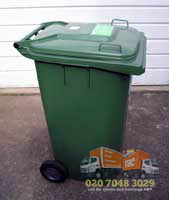The invention and implementation of the Dempster-dumpster waste removal system was good news for the industry, no doubt about it. Having said this, there was still the need for an even more efficient and quicker rubbish collection method. The new system arrived shortly after in the late nineteen thirties, early forties.
 The company that developed the new rubbish removal system was Garland, with their Load Packer. The idea at Garland was to fit purpose built rubbish trucks with garbage compactors also known as compressors. This innovation completely transformed the waste collection industry. The compressors and compactors fitted on these trucks were one of the first ever attempts at actual waste management, instead of just collection and dumping.
The company that developed the new rubbish removal system was Garland, with their Load Packer. The idea at Garland was to fit purpose built rubbish trucks with garbage compactors also known as compressors. This innovation completely transformed the waste collection industry. The compressors and compactors fitted on these trucks were one of the first ever attempts at actual waste management, instead of just collection and dumping.
About a decade later – midway through the nineteen fifties, the Dempster Company took it up a notch with the introduction of the Dempster Dumpmaster. The Dumpmaster rubbish removal system featured a specially equipped rubbish truck known as a front loader. The front loader system used a fork (much similar to the one used by forklifts) in order to secure, lift and tip the dumpster inside the truck compactor. The lifting fork and mechanism were attached to the truck. The fork was retractable so that the vehicle can move freely at a normal pace, without losing its manoeuvrability when not collecting rubbish.
The front loaders did not become too popular at the start for some reason, perhaps innovation tends to scare some individuals, who knows. In the nineteen seventies though, the front loader system really came into its own and many countries began to appreciate its functionality and efficiency. Around the same time, Dempster came out with a smaller sized dumpster, which we now know as the wheelie bin. The implementation of the wheelie bin for domestic use meant that yet a gain new rubbish removal system had to be put in place.
The nineteen sixties and nineteen seventies saw the invention and implementation of the hydraulic, high powered compaction and grinder systems that we know today. Although those early versions were somewhat less efficient than the ones used today, they were signalling change and shaping the future of modern waste collection and management practices.
The first examples of these advanced, high powered rubbish collection mechanisms and systems were the brainchild of innovative (and well-funded) engineering groups in West Germany and France. The waste collection and processing industry had evidently come a long way since the corkscrew mechanism days of the early twentieth century.



